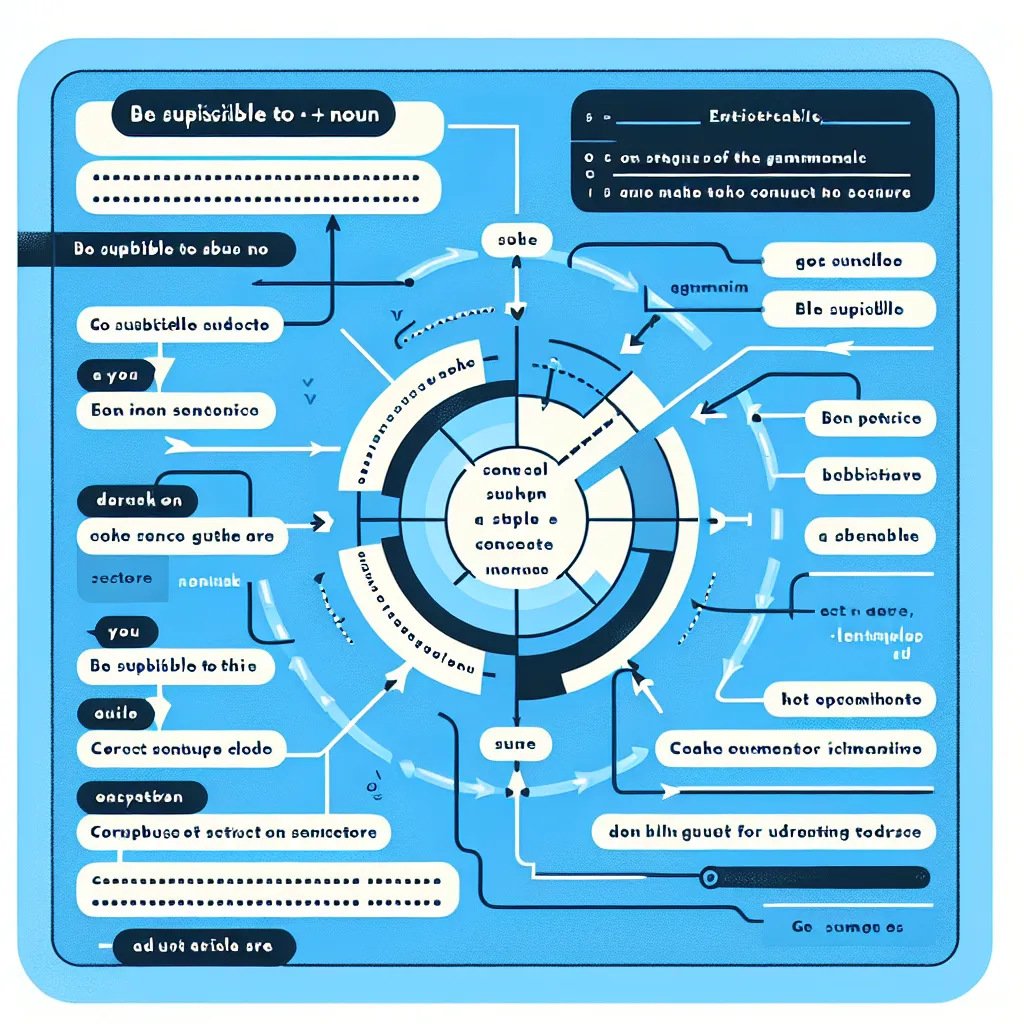The expression “be susceptible to + noun” is a crucial grammatical structure that frequently appears in IELTS exams. Understanding its usage can significantly enhance your performance across all sections of the test. Let’s delve into this construction and explore how to effectively incorporate it into your IELTS preparation.
Some examples of using “be susceptible to + noun” in IELTS-style sentences:
- Elderly people are often more susceptible to respiratory infections.
- Developing countries are susceptible to economic fluctuations in global markets.
- Students under stress may be susceptible to anxiety and depression.
- Coastal regions are particularly susceptible to the effects of climate change.
- New technologies are susceptible to security breaches in their early stages.
In these examples, we can see how the structure is used to describe vulnerability or sensitivity to various conditions or influences. This versatility makes it a valuable tool for expressing complex ideas in both the Writing and Speaking sections of IELTS.
Understanding “Be Susceptible to + Noun”
The phrase “be susceptible to + noun” is used to express that someone or something is likely to be affected by or vulnerable to a particular condition, influence, or action. It’s a common structure in academic and formal English, making it particularly relevant for IELTS candidates aiming for higher band scores.
Grammatical Structure
The basic formula for this structure is:
[Subject] + [be verb] + susceptible + to + [noun/gerund]
The subject can be a person, group, object, or concept. The be verb should agree with the subject in tense and number. The noun following “to” can be a simple noun, a compound noun, or a gerund (verb + -ing form used as a noun).
 Grammatical structure of 'be susceptible to'
Grammatical structure of 'be susceptible to'
Application in IELTS Writing
In the IELTS Writing task, using “be susceptible to + noun” can demonstrate a sophisticated grasp of English grammar and vocabulary. Here’s how you can incorporate it into your essays:
Task 2 Essay Example:
Topic: Environmental Issues
Paragraph excerpt:
Climate change poses significant threats to biodiversity worldwide. Many species are susceptible to habitat loss due to rising temperatures and changing weather patterns. For instance, polar bears are particularly susceptible to the melting of sea ice, which directly impacts their hunting grounds and breeding areas. Moreover, coral reefs are highly susceptible to ocean acidification, a direct result of increased carbon dioxide absorption by the world’s oceans.
In this example, the structure is used three times to emphasize the vulnerability of different species to various aspects of climate change. This repetition, using different subjects and nouns, showcases a strong command of the language and the ability to discuss complex topics coherently.
Enhancing IELTS Speaking Responses
For the Speaking test, incorporating “be susceptible to + noun” can elevate your responses, especially in Parts 2 and 3 where more complex language is expected.
Speaking Part 3 Example:
Question: How do you think technology affects people’s health?
Sample answer:
Well, I believe technology has both positive and negative impacts on health. On the one hand, medical advancements have made us less susceptible to many diseases that were once life-threatening. However, our increased reliance on technology has made many people more susceptible to sedentary lifestyles, which can lead to obesity and related health issues. Additionally, constant exposure to screens has made many individuals susceptible to eye strain and sleep disorders. It’s a double-edged sword, really, and we need to find a balance to harness the benefits while minimizing the risks.
This response demonstrates a nuanced understanding of the topic while skillfully employing the target structure three times, each with a different noun complement.
Common Errors and How to Avoid Them
When using “be susceptible to + noun”, IELTS candidates often make several mistakes:
-
Incorrect preposition: Using “of” or “for” instead of “to”.
- Incorrect: She is susceptible of colds.
- Correct: She is susceptible to colds.
-
Using an adjective instead of a noun: The structure requires a noun or gerund.
- Incorrect: They are susceptible to depressed.
- Correct: They are susceptible to depression.
-
Forgetting the “be” verb: The structure requires a form of “be”.
- Incorrect: The company susceptible to market changes.
- Correct: The company is susceptible to market changes.
-
Misusing tenses: Ensure the “be” verb agrees with the subject and context.
- Incorrect: The ancient artifacts was susceptible to damage.
- Correct: The ancient artifacts were susceptible to damage.
-
Overuse: While it’s a useful structure, overusing it can make your writing or speaking seem repetitive.
To avoid these errors, practice using the structure in various contexts and review your usage carefully. Pay attention to noun forms and subject-verb agreement.
Strategies for Higher Band Scores
To achieve higher band scores in IELTS, consider these strategies when using “be susceptible to + noun”:
-
Vary your vocabulary: Use synonyms for “susceptible” like “prone to”, “vulnerable to”, or “liable to” to demonstrate lexical resource.
-
Combine with other complex structures: For example, “Despite their robust appearance, large trees are often more susceptible to wind damage than smaller, more flexible saplings.”
-
Use in conjunction with topic-specific vocabulary: For instance, in a discussion about economics, “Emerging markets are susceptible to currency fluctuations, which can deter foreign investment.”
-
Employ it in different parts of speech: Use the noun form “susceptibility” or the adverb “susceptibly” where appropriate.
-
Create complex sentences: Combine the structure with dependent clauses or other advanced grammatical forms.
Conclusion
Mastering the use of “be susceptible to + noun” can significantly enhance your performance in the IELTS exam. By understanding its structure, practicing its application, and avoiding common errors, you can demonstrate a sophisticated command of English grammar and vocabulary. Remember to use it judiciously and in conjunction with other advanced language features to achieve the best results across all sections of the IELTS test.
For further practice, consider using this structure in essays about health, environment, technology, or economics, where discussions of vulnerability and sensitivity are particularly relevant. The more you integrate it into your language use, the more natural and effective your IELTS responses will become.


